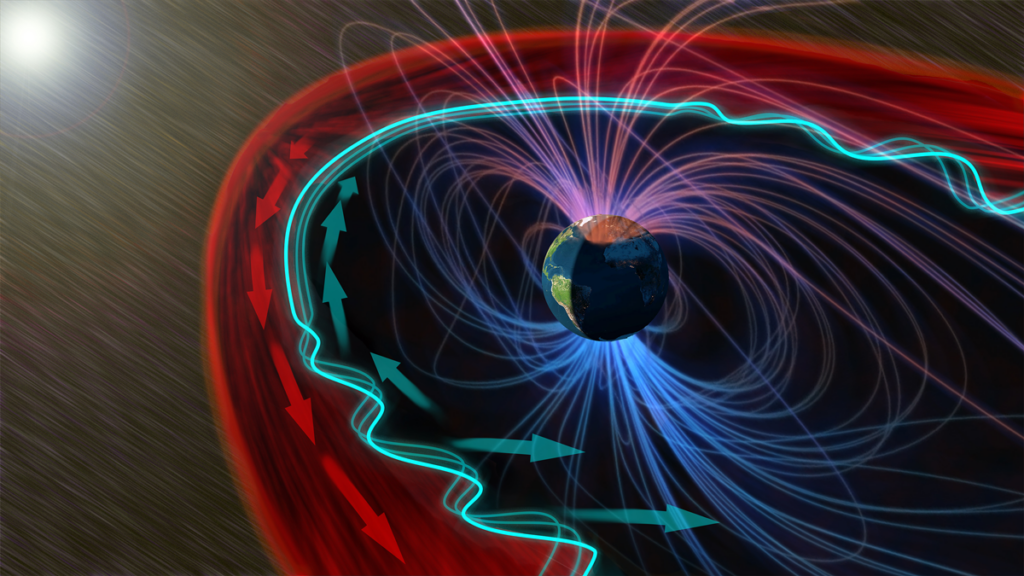Space isn’t just silent nothingness. It’s buzzing with charged particles expelled from the Sun and lofted along by solar winds. Gusty and energetic solar winds can send ultralow-frequency waves quivering along the magnetic field lines that surround our planet—just like a harp string when plucked.
“We’re hoping that the wisdom of the crowd, combined with our highly tuned human sense of hearing, will help us pick out the features of these waves.”
This haunting melody is too low in pitch for us to hear, but researchers have turned these sounds into something audible and are now asking the public to help listen to the din of space.
“We’re hoping that the wisdom of the crowd, combined with our highly tuned human sense of hearing, will help us pick out the features of these waves,” said Martin Archer, a space physicist with Imperial College London and one of the scientists behind the project—Heliophysics Audified: Resonances in Plasmas (HARP).
By classifying the different types of vibrations, the researchers hope to get a better picture of how they influence Earth’s magnetic field.
Sounding Out the Notes
Stunning aurorae, seen dancing across skies near the poles, is one illustration of how plasma energy carried by solar winds can interact with Earth’s magnetic field, or magnetosphere.
Beyond creating colorful light displays, waves generated when our magnetosphere is struck by solar winds also contribute to disruptive space weather, which can pose a risk to satellites, telecommunications, and astronauts.
“Audio analysis could add a new dimension to our understanding of plasma waves.”
Characterizing plasma waves could help improve predictions of space weather hazards. But studying them has proved challenging in the past because even computers struggle to separate out the many simultaneous vibrations among the background noise of space.
“These plasma waves are really complicated,” said Wen Li, an astronomer at Boston University who is not involved in the HARP project. “Even after decades of study, we still have a lot of questions about how they work.” One unknown the researchers hope to explore is why some plasma waves interact with their space environment more strongly than others. “Audio analysis could add a new dimension to our understanding of these waves,” Li said.

To amplify the sound of plasma waves for human ears, the researchers used a technique called sonification to speed up years of electromagnetic measurements collected by NASA’s THEMIS mission (Time History of Events and Macroscale Interactions during Substorms), which deployed five satellites to fly through Earth’s magnetosphere in 2007.
Back in 2018, Archer trialed a small-scale version of the project with high school students, who identified a series of solar storms reverberating within Earth’s magnetosphere. Each storm sounded like a loud crunch, followed by whistles that steadily pitched down as the magnetic field lines readjusted. “Space scientists had barely discussed sounds like this before,” Archer said. The storms “leapt out at us when we listened to the data but were easy to miss in the plots.”
Since that discovery, with the backing of NASA, the HARP team has worked with sound experts to create an interface that allows people to highlight and comment on the waveforms. The researchers are asking volunteers to listen to the audio and describe what they hear—whether the sound is a formless static noise or pure tone, for instance.
Borrowing techniques used by musicians was fundamental to the project, said Archer, who has a background in radio and as a DJ. “It struck me that these data might be better suited to our ears.”
“Hearing these waves really brings them to life,” said David Sibeck, a heliophysicist at NASA Goddard Space Flight Center and a THEMIS mission scientist who is not involved in the HARP project. The huge bank of data gathered by the mission has been a challenge for scientists to analyze by themselves, Sibeck said.
Aside from being a way to engage the public in space science endeavors, asking folks to listen to the data also brings scientific benefits. Humans excel at disentangling competing sounds, even set against background noise, Archer explained. “Take our ability to filter out conversations at a cocktail party.”
An Ear on Space
One of the team’s goals is to identify the properties of each plasma wave. Just like the strings of a harp, each wave resonates and interacts with its surrounding space differently. Certain plasma waves are thought to play a role in forming the giant doughnut-shaped radiation belts—or Van Allen belts—within Earth’s magnetosphere. These belts, which contain highly charged particles, are a major hazard for astronauts and spacecraft because of high radiation levels.
Current theories suggest that plasma waves can energize the charged particles in these belts, making them more hazardous. Stronger plasma waves with larger amplitudes are thought to be more effective at transferring energy between particles, said Li, “but we are still unsure exactly how this process works.”
Observations from HARP could help scientists understand that energy transfer, Sibeck said. “We really won’t know which waves are important until we survey them all.” The public contribution will be crucial to the success of the project, Archer said.
—Erin Martin-Jones (@Erin_M_J), Science Writer



